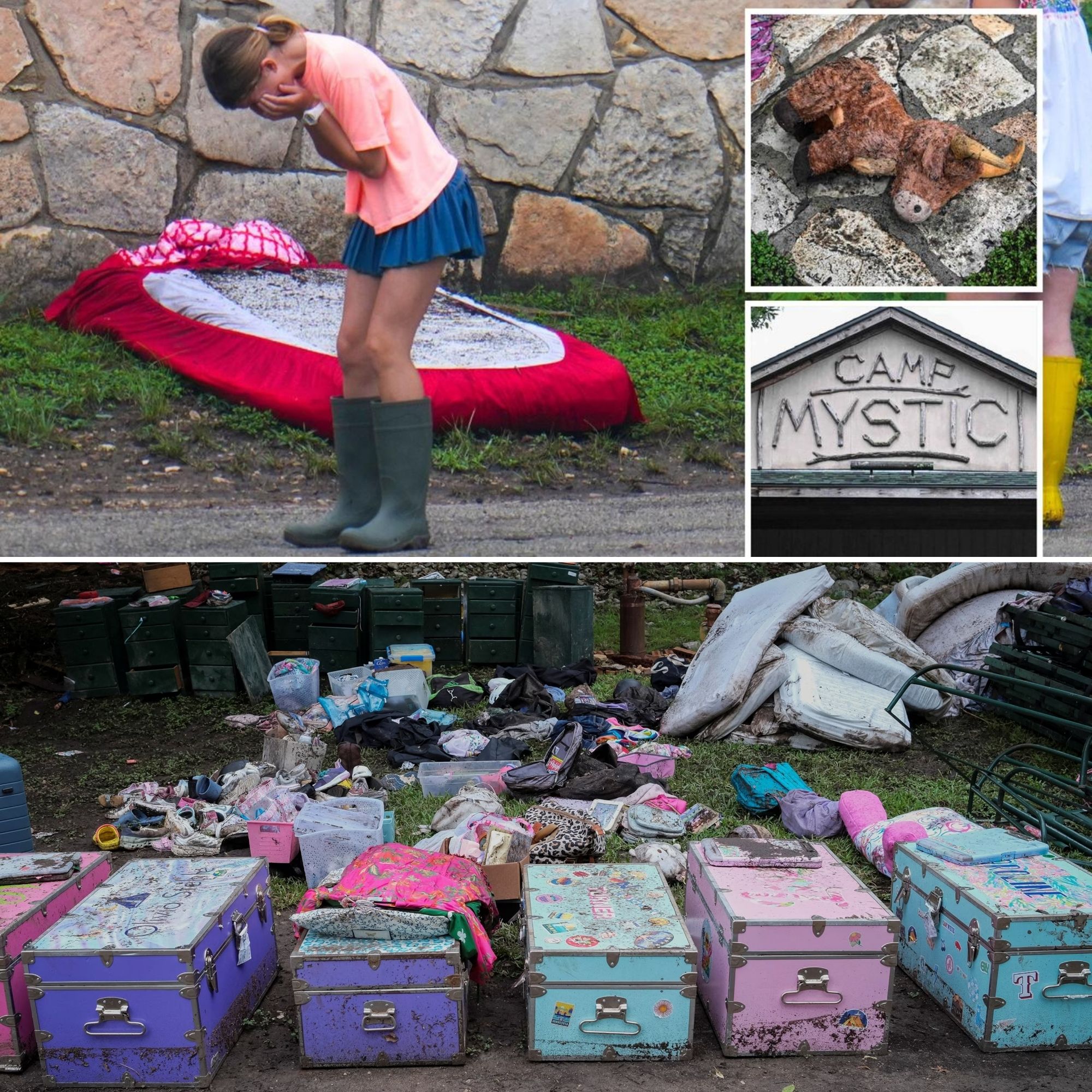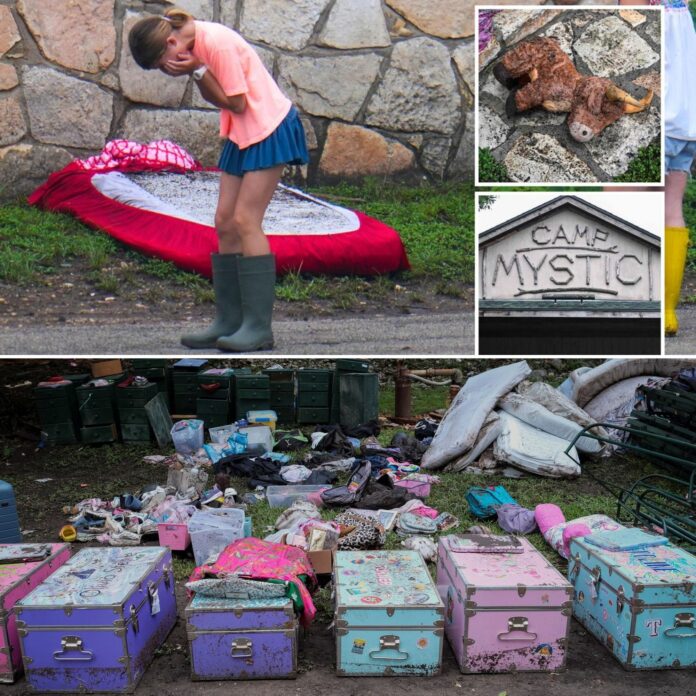🌊 “One minute asleep, the next wading through chest-deep terror…” A Texas teen’s chilling escape from floods that struck without warning. How did strangers become saviors in the dead of night? The water rose so fast… Uncover her heart-pounding survival tale

The Texas Hill Country, known for its scenic rivers, lush hills, and vibrant holiday getaways, became a scene of unimaginable horror on July 4, 2025. What began as a festive Independence Day weekend for thousands turned into a deadly flash flood along the Guadalupe River, claiming over 100 lives and leaving communities devastated. Among the survivors is 19-year-old Riata Schoepf from Belton, Texas, whose account of escaping chest-level water that “came out of nowhere” captures the sudden, merciless nature of the disaster. This article explores the events of that fateful night, Riata’s gripping ordeal, the broader impact on the region, and the lessons emerging from one of the worst flooding events in Texas history.
The Onset of Disaster: A Holiday Turned Nightmare
Flash floods are a perennial threat in Central Texas, where the region’s karst topography—porous limestone that funnels rainwater directly into rivers—can turn a downpour into a deluge in minutes. On July 3, 2025, a slow-moving storm system parked over the area, dumping inches of rain hourly. By midnight, the Guadalupe River, a popular spot for tubing, camping, and family vacations, began to swell rapidly. In Kerr County, towns like Hunt, Ingram, and Kerrville bore the brunt, with water levels rising over 20 feet in under an hour.
Riata Schoepf was vacationing with a large group of 33 friends and family at the River Inn & Conference Center in Hunt, a quaint hotel nestled near the riverbank. The group had enjoyed a typical holiday evening—barbecues, laughter, and plans for fireworks—oblivious to the brewing storm. Around 2:30 a.m., chaos erupted. Riata recalls a frantic knock on her door: her boyfriend’s brother bursting in, yelling, “We have to get out—there’s flooding, we have to leave now.” Stepping outside, she was stunned. The water had already engulfed picnic tables and was lapping at the bottom-floor doors. “It was insane. It just came out of nowhere,” she later told reporters, her voice still laced with disbelief.
The group rushed to their vehicles, hoping to drive to higher ground. But the roads were jammed with panicked evacuees, and the water continued its relentless rise. Trash cans, debris, and even cars were being shoved aside by the current. Riata described the scene as shocking, like nothing she’d ever witnessed. With traffic at a standstill and water seeping into her car, the decision was made to abandon the vehicles. “We were at a standstill. At this point, there’s nowhere else for us to go,” she said.
Riata’s Escape: Wading Through the Abyss
As Riata and her companions fled on foot, the water rose alarmingly fast—from knee-high to waist-deep, then chest-level in what felt like moments. The dead of night amplified the terror: pitch-black surroundings pierced only by flashes of lightning and the distant rumble of thunder. The current tugged at their legs, threatening to sweep them away. Riata, navigating through the debris-filled torrent, felt the panic set in. She attempted to text her father, Ronnie Schoepf, a Belton businessman who owns Schoepf’s BBQ, but cell service was spotty in the remote area. Messages sent between 4 a.m. and 5 a.m.—detailing the rising waters and her desperate trek—didn’t reach him until nearly 8 a.m.
The group’s salvation came unexpectedly. As the water neared their chests, they passed a two-story house where survivors on the upper floor shone flashlights into the darkness. Spotting Riata and her companions, they screamed for them to come up. “The current was just pulling more and more people in,” Riata recounted. The strangers threw down a bedsheet, improvising a lifeline to hoist the group to safety one by one. Huddled on the second floor with these Good Samaritans, Riata waited out the night, grateful but haunted by the screams and chaos below.
Meanwhile, back in Belton, Ronnie Schoepf was gripped by fear. Upon hearing about the floods, he jumped in his car and drove through the rain toward Hunt, only to be turned back by roadblocks near Marble Falls. “I took off driving in the rain and got all the way to the other side of Marble Falls when the phone rang, and they said they weren’t gonna get out,” he later shared. For 18 agonizing hours, he waited for news, imagining the worst. Relief came when Riata was finally rescued by first responders, though the ordeal left him reflecting, “There was relief knowing that she’s not sitting on a rooftop.”
Riata’s story is one of survival against odds, but it underscores the flood’s brutality. The group of 33 splintered in the confusion, reuniting in fragments over the following days. Some clung to rooftops, others were swept downstream, but miraculously, all in her immediate circle made it out alive.
The Wider Devastation: Lives Lost and Communities Shattered
Riata’s escape was one of the fortunate ones in a catastrophe that claimed at least 104 lives across Central Texas, with Kerr County alone reporting 84 fatalities, including 28 children. Many victims were at summer camps or vacation spots, caught asleep when the waters hit. Rescue teams combed debris fields for days, recovering bodies from tangled wreckage along the riverbanks. The floods obliterated homes, bridges, and infrastructure, displacing thousands and causing billions in damage.
Survivors’ tales echo Riata’s themes of suddenness and community heroism. In Ingram, neighbors formed human chains to pull people from the currents. A man in Comfort stood on a meter box for three hours, clinging to life amid the torrent. Campers at sites like Camp Mystic swam through raging waters, hearing cries for help that faded into the night. An 80-year-old resident described waking underwater, her home overrun by the Guadalupe’s fury.
The psychological toll is profound. Riata spoke of the heartbreak for those still missing, criticizing attempts to politicize the disaster. “This came out of nowhere. Turning it into a political or government issue is so sad. People are dying, and we’re trying to redirect the focus,” she said. Many survivors report nightmares, anxiety during rain, and survivor’s guilt. Mental health support has been mobilized, but resources are strained.
Economically, the Hill Country’s tourism industry—reliant on river activities—ground to a halt. Hotels like the River Inn were destroyed, farms flooded, and local businesses faced ruin. Federal aid arrived, but delays in distribution forced reliance on community fundraisers and donations.
Response and Recovery: Heroes Amid the Wreckage
First responders transitioned from rescue to recovery by mid-July, using drones and boats to navigate treacherous terrain. Volunteers from across Texas, including church groups and nonprofits, cleared debris and provided aid. “Texans helping Texans” became a mantra, with acts like a young girl crafting bracelets for rescuers symbolizing hope.
Controversies emerged over preparedness. Why weren’t evacuation orders issued sooner? Meteorological warnings were in place, but the holiday may have led to complacency. Lawmakers promised investigations, advocating for better early-warning systems, floodplain mapping, and camp relocations. Climate experts noted that warming trends are intensifying storms, making such events more frequent.
Riata’s group exemplified community resilience. Reunited, they focused on supporting others, donating to relief efforts. Her father, Ronnie, emphasized gratitude: “She’s home safe, and that’s what matters.”
Looking Forward: Building Resilience in a Changing Climate
The July 2025 floods highlight the need for proactive measures. Texas officials are proposing expanded siren networks, real-time river gauges, and education on flood safety protocols like “Turn Around, Don’t Drown.” Environmentalists call for preserving riparian buffers to absorb runoff, countering urbanization’s effects.
Riata’s story inspires hope. Now back in Belton, she reflects on the strangers who saved her: “In that moment, people you don’t know become family.” The Guadalupe River, once a source of joy, now bears scars, but the human spirit endures.
As recovery continues, the disaster serves as a wake-up call. With over 100 lives lost and countless affected, Texas must invest in prevention to avert future tragedies. Riata’s words—”It came out of nowhere”—remind us of nature’s unpredictability, but also of our capacity for courage and unity.
In the end, the floods tested the Hill Country’s resolve, but stories like Riata’s show that even in chest-deep despair, hope can rise. The region rebuilds, honoring the lost by forging a safer path ahead, ensuring no one faces the river’s wrath unprepared again.
To further contextualize, the Guadalupe River spans over 230 miles, its volatility amplified by upstream development. Similar events in 2015 and 2018 foreshadowed this, yet vulnerabilities persisted. Personal anecdotes continue: a father sacrificing himself for his family, teenagers forming human ladders. The economic hit—$2.5 billion—spurs calls for mandatory flood insurance.
Psychologically, PTSD looms large, with counseling vital. Policy shifts include smart sensors for alerts. Globally, parallels to floods in Europe and Asia underscore climate urgency. By heeding survivors like Riata, Texas can transform tragedy into triumph, outpacing the next storm.
